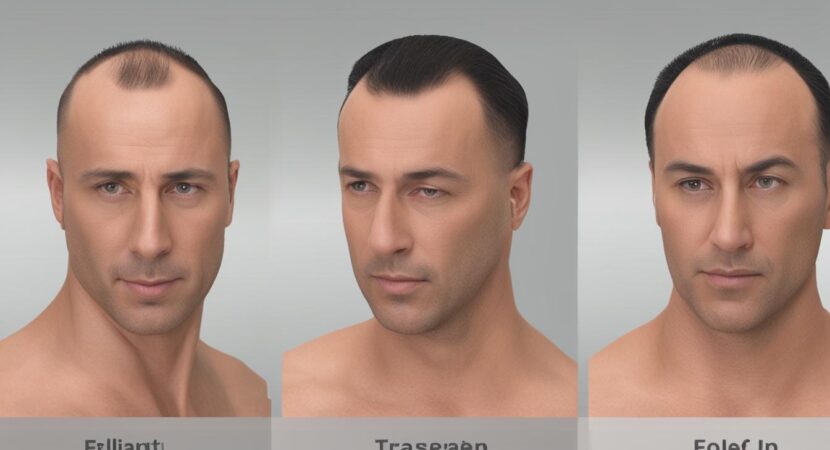For individuals experiencing the distress of hair loss, a Follicular Unit Extraction (FUE) hair transplant presents a cutting-edge hair restoration solution, offering a path to reclaim not only your locks but also your confidence. Among the foremost advantages of FUE hair transplant is the minimal scarring it leaves behind, making it a discreet and appealing option for many. Following the procedure, patients are often pleasantly surprised by the FUE recovery time, which is relatively swift, allowing them to return to their daily routines with ease and new hair growth.
This innovative technique involves the careful extraction of individual hair follicles, which are then skillfully transplanted to thinning or bald areas. The precision of this method results in a remarkably natural look, avoiding the linear scarring common with traditional methods. Thus, the FUE method stands out in the realm of hair transplants for its ability to marry efficiency with aesthetically pleasing outcomes.
Key Takeaways
- The FUE hair transplant process is recognized for delivering a fuller head of hair with inconspicuous scarring.
- FUE procedures offer a speedy recovery, enabling patients to quickly resume their everyday lives.
- Due to its precise follicle extraction, FUE ensures a natural and seamless hair appearance.
- This method reduces long-term care needs as there’s little to no traceable scarring post-procedure.
- FUE is a preferred hair restoration solution for its less invasive nature and efficient healing.
Understanding FUE Hair Transplant Procedure
The landscape of hair restoration has been revolutionized by the emergence of FUE, a highly sophisticated hair transplant technique with a focus on precision and natural outcomes. Let’s delve into the process and rationale behind this method’s growing popularity.
What is FUE Hair Transplantation?
Follicular Unit Extraction, commonly known as FUE, is a leading-edge hair follicle transplantation method where individual follicular units are meticulously harvested from a donor site and transplanted into areas affected by hair loss. Contrasting with older techniques, FUE is celebrated for its minimally invasive nature and ability to create a natural-looking hairline without the need for a scalpel or sutures—leaving virtually no visible scarring.
The Step-by-Step FUE Process
The FUE hair restoration process encompasses several intricate steps to ensure the structures of the hair follicles are preserved during extraction and transplantation:
- Preparation: Initial consultation to assess the patient’s suitability and delineate the hairline.
- Hair Follicle Extraction: Using a specialized micro punch tool, individual follicles are extracted one at a time.
- Recipient Site Creation: Tiny incisions are made in the treatment area to accommodate the extracted follicles.
- Transplantation: Harvested follicles are then carefully placed into the prepared incisions.
Each step is carried out with meticulous care, ensuring the vitality of the follicles and promoting successful integration into the recipient area.
Why Choose FUE Over Other Techniques?
FUE hair restoration has gained traction as a preferred choice for many due to its distinct advantages over older hair transplantation methods. A significant benefit is the absence of a linear scar, presenting an ideal option for those who wear their hair short. Furthermore, the technique reduces recovery time and discomfort, making it a patient-centric approach for natural and effective hair restoration.
Sourced from reputable organizations such as the American Academy of Dermatology and in-depth studies from the Journal of Cutaneous and Aesthetic Surgery, it is evident that the FUE method has established itself as a leader in hair follicle transplantation. Comparative analyses, like those published in the International Journal of Trichology, underscore FUE’s reduced invasiveness and quicker recovery—factors that are especially important for patients seeking both efficiency and discretion in treatment.
Key Benefits of FUE Hair Transplant
The Follicular Unit Extraction (FUE) methodology boasts an array of benefits that have solidified its reputation within the hair restoration field. Among these, the promise of lasting hair transplant results, less invasive hair restoration procedures, and versatility in hair transplants stand out as the most substantial. Clinical case studies from the International Society of Hair Restoration Surgery, coupled with insights from top-tier hair transplant surgeons, highlight the transformative impact of FUE. Additionally, patient experiences shared on medical aesthetic forums attest to the enduring benefits and satisfaction associated with this state-of-the-art treatment.

Natural-looking Results
When it comes to hair transplants, a paramount concern for patients is the natural appearance of the final outcome. FUE delivers convincingly natural results, replicating the hair’s natural growth pattern and density with precision. This advanced technique ensures a seamless blend between transplanted follicles and existing hair, a critical factor for long-term satisfaction and confidence.
Minimally Invasive Nature
The less invasive nature of FUE stands as a game-changer in the realm of hair restoration. Unlike traditional hair transplantation methods that may involve significant incisions and extended recovery periods, FUE is a minimally invasive option with less discomfort and faster healing. Its meticulous approach to follicular extraction means shorter recovery times and fewer post-procedure limitations, positioning it as a superior choice for many patients.
Flexibility for Any Hair Type
With the versatility in hair transplants afforded by FUE, a broader demographic of patients can find a tailored solution to hair loss. Irrespective of hair type or texture, FUE can be adapted to meet individual needs, allowing trichologists to craft precise treatment plans. This versatility not only broadens the appeal of FUE but also increases the potential for personalization, ensuring that each patient’s unique hair restoration goals are successfully met.
| Benefit | Description | Patient Impact |
|---|---|---|
| Lasting Results | Highly successful follicle transplantation mimicking natural hair growth. | Sustained hair density and appearance. |
| Minimally Invasive | Micro punch technology for graft extraction with minimal scarring and discomfort. | Streamlined recovery and reduced downtime. |
| Versatility | Customizable to various hair types and patterns. | Widens candidacy for the procedure; personalization of treatment. |
Pre-operative Care for FUE Transplants
Embarking on the journey of an FUE hair transplant requires more than just walking into the clinic on the day of the procedure. Optimal outcomes hinge on thorough FUE transplant preparation. To navigate through the process with ease, patients are encouraged to engage in a comprehensive hair transplant consultation and adhere to prescribed pre-surgery care practices. This preparation phase is crucial for securing the highest possible success rate for the surgery and ensuring the health and safety of the patient.
Consultation and Planning
At the heart of the pre-operative phase is the hair transplant consultation. During this meeting, patients receive tailored advice and have a personalized surgery plan developed. The planning process covers everything from the identification of the donor area to the meticulous designing of the anticipated hairline. It’s during this time that the patient can ask questions, address concerns, and be informed of the specifics of their procedure. Not only does this consultation foster a sense of preparedness, but it also establishes realistic expectations for the surgical outcome.
What to Do Before Your Procedure
The pre-operative instructions may vary from clinic to clinic, but there are commonalities applicable to all patients gearing up for an FUE transplant. It’s advisable to:
- Avoid any hair treatments or dyeing a few weeks before the surgery.
- Refrain from consuming alcohol and smoking as they may affect healing.
- Stay hydrated and maintain a healthy sleep schedule.
- Arrange for transportation to and from the clinic since sedatives or anxiety medications may be administered.
Adhering to these directives not only primes the body for the procedure but also paves the way for a smoother recovery.
Diet and Medication Considerations
Subtle dietary adjustments and medication awareness can also play a pivotal role in pre-surgery care. Patients are generally advised to avoid taking blood-thinning agents, such as aspirin or certain anti-inflammatory drugs, for a period leading up to the transplant. Herbal supplements known to increase bleeding risks, like ginkgo biloba or garlic, should also be suspended.
Nutrition-wise, patients should focus on meals rich in vitamins and minerals that support immune health and wound healing. An intake of protein, vitamin C, and iron is particularly beneficial. Still, any significant changes to diet or medication should always be communicated to and discussed with the attending physician to ensure safety and suitability.
Post-operative Care and Recovery Phase
Embarking on an FUE hair transplant recovery journey is an experience that requires diligent post-operative care for the best outcomes. This phase is critical as it lays the groundwork for optimal hair regrowth and ensures patient comfort throughout the healing process. Real-life recovery accounts highlight that timely and appropriate care following an FUE procedure can significantly influence both the aesthetic results and overall satisfaction of patients.
Immediate Post-op Care
Right after the FUE hair transplant, the scalp requires gentle handling to facilitate proper healing. Leading FUE transplant centers recommend keeping the scalp dry, especially on the first day, to aid the newly placed follicles in settling. Instructions typically include sleeping in an elevated position to minimize swelling and applying ice packs—never directly on the transplanted area—as advised to counter discomfort. Adhering scrupulously to the post-operative care regimen provided by your surgeon will be pivotal in this initial phase of recovery.
Managing Discomfort and Swelling
Post-surgical swelling and discomfort are common, but manageable aspects of the healing process. Strategies such as taking prescribed pain relief medication and following a proper icing schedule can effectively control these symptoms. Dermatologic research underscores the importance of avoiding any strenuous activity that might exacerbate swelling during the initial post-operative days. Moreover, understanding that mild tingling or itchiness as the scalp heals is normal, helps patients to manage their comfort levels during this delicate time.
Timeline for Recovery and Hair Growth
Patients often inquire about the hair growth timeline, eager to see the fruits of their investment. While initial recovery from FUE surgery typically takes about one to two weeks, the journey to full hair growth is gradual. It’s common to observe some hair fall within the first few months—this is a natural part of the process before permanent hair growth commences. Significant hair growth usually becomes noticeable after six to nine months, with full results typically seen after one year. Keeping these timelines in mind enables individuals to have realistic expectations and patience as they await their new, full head of hair.


No Responses - Add Comment